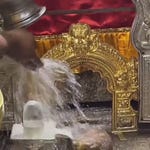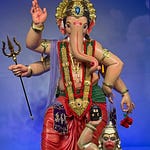Nestled in the lap of the Shatrunjaya Hills in Paliitana, Gujarat, lies one of the most sacred and awe-inspiring religious complexes in the world — the Paliitana Jain Temples. Often called the "Vatican of Jainism", this place is revered by millions of Jain devotees across the globe. This is not just a temple or a monument; it is a spiritual galaxy of over 900 intricately carved marble temples, rising atop a sacred mountain.
📜 Historical Background and Timeline
The origins of the temples trace back to the 11th century CE, although the hills were considered holy long before that.
The first temples were built under the patronage of King Kumarpal of the Solanki dynasty, a devout follower of Jainism.
Over time, wealthy Jain merchants, saints, and dynasties contributed to building and renovating these temples, especially between the 11th to 16th centuries, continuing even today.
The site is continuously rebuilt and restored as Jains believe no temple here can be considered "complete forever" — because the very act of rebuilding is considered an act of supreme piety.
🛐 Religious and Spiritual Significance
Shatrunjaya literally means “a place of victory against inner enemies”. The climb itself is symbolic of a devotee’s spiritual ascent.
According to Jain beliefs, Lord Rishabhdev (Adinath), the first Tirthankara, gave his first sermon on this hill.
It is believed that 23 out of 24 Tirthankaras have sanctified this hill by their presence.
The hill is considered more sacred than any other place, and visiting Paliitana at least once in a lifetime is a must for every Jain.
Unlike most other holy sites, no one is allowed to stay overnight on the hill as it is considered so pure that even monks must descend before sunset.
🌄 Temple Complex Details
The climb to the top involves ascending around 3,750 stone steps, spread over a distance of 3.5 km.
At the summit, devotees are greeted with a dazzling view of marble temples, each carved with divine precision.
The temples are clustered into nine major enclosures, each known as a tunka (group of temples).
The main temple is dedicated to Shri Adinath (Rishabhdev Bhagwan), adorned with a beautiful idol in a meditative posture.
The entire complex exudes peace, divinity, and awe — a majestic silence engulfed in chants and the rustle of holy robes.
🧘♂️ Puja, Aarti, Bhajan, and Rituals
Daily Rituals:
Snatra Puja – Morning bath and purification ceremony for the idol.
Abhishek Puja – Sacred bath using water, milk, and saffron.
Pushpa Vandan – Offering of flowers and chanting of hymns.
Aarti – Performed with lamps and incense during morning and evening. It resonates with the divine peace and tranquility of the site.
Bhajan:
Devotees often sing Jain Stavans and Bhaktamar Stotras, echoing ancient hymns in praise of Tirthankaras.
Bhajans are sung in groups or solo, especially before and after darshan, creating a vibrant spiritual atmosphere.
🕰️ Temple Timings
Temple opening time: 5:00 AM
Temple closing time: 6:00 PM (All devotees must descend before sunset)
Best time to start the climb is between 4:30 AM to 6:00 AM to avoid heat and complete the pilgrimage by noon.
Aarti timings: Typically around 5:30 AM and 5:00 PM, though they may vary by season and occasion.
🧗♀️ The Spiritual Climb
The ascent is a journey of faith — no vehicles or lifts are allowed.
Devotees may take ‘dolis’ (palanquins) if physically unable to climb.
Many elderly devotees do the climb multiple times a day, especially during the holy Chha Gau Yatra.
The climb is a metaphor for the soul’s rise from earthly attachment to spiritual liberation.
🛣️ How to Visit
Nearest Airport: Bhavnagar Airport (56 km)
Nearest Railway Station: Palitana Railway Station
By Road: Well connected via Ahmedabad (220 km), Bhavnagar (56 km), Vadodara (290 km)
You can hire a taxi or take buses from Bhavnagar or Ahmedabad.
🏨 Stay and Accommodation
Dharamshalas (Jain guesthouses) are available in and around Paliitana for pilgrims.
These are usually managed by Jain trusts and offer clean, vegetarian-only stay options at nominal charges.
A few budget hotels and lodges are available in Palitana town.
Food served is strictly Jain sattvic, avoiding root vegetables during certain months.
🛕 Nearby Pilgrimage Sites and Temples
Taleti: The base of the hill with temples and starting point of the climb.
Shri Vishal Jain Museum: A collection of rare Jain scriptures, artifacts, and statues.
Kundalpur Jain Temple: A lesser-known but ancient Jain site near Paliitana.
Ganga Deri: An intricately carved stone structure halfway up the hill.
Adinath Temple (First): Main temple at the summit.
Chaumukhji Temple: Four-faced idol symbolizing infinite vision.
Shri Nandishwar Dweep: A replica of the heavenly Jain island.
🙏 Devotee Significance and Pilgrimage Practices
Many devotees observe Maun Vrata (vow of silence) during their ascent.
Several undertake Ekasana (one meal a day) or Upvas (fasting) during their pilgrimage.
Devotees consider touching the marble steps as sacred, often bowing at each stretch.
It is believed that those who climb Paliitana with pure intent cleanse their karmas and prepare their soul for moksha (liberation).
📅 Festivals and Special Events
Paryushan Parva (August–September): The most important Jain festival. Thousands of devotees visit Paliitana.
Mahavir Jayanti: Celebrated with grandeur and devotional fervor.
Chha Gau Yatra: A week-long spiritual trek covering six major Jain tirths in the region.
Kartak Poornima: A highly auspicious full moon when lakhs of pilgrims undertake the climb.
The Paliitana Temple Complex is not just a religious site — it is a living spiritual monument, a testament to devotion, non-violence, peace, and the pursuit of liberation. Despite its grandeur and scale, it remains under-celebrated globally.
It is time we recognize this marvel — not merely as a religious place for Jains, but as a jewel of Indian spiritual heritage, a symbol of divine architecture, and an eternal source of peace and transcendence.
Let this sacred hill of Paliitana inspire more hearts, more seekers, and more souls around the world.
Jai Jinendra | जय जिनेन्द्र | Jai Shatrunjaya Parvat!









